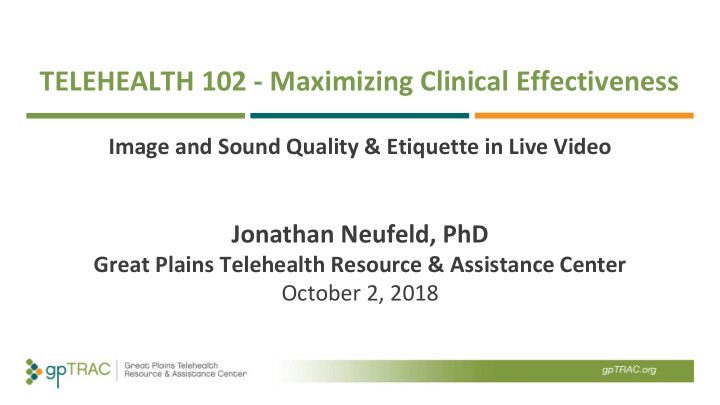



TELEHEALTH 102 - Maximizing Clinical Effectiveness Image and Sound Quality & Etiquette in Live Video Jonathan Neufeld, PhD Great Plains Telehealth Resource & Assistance Center October 2, 2018
Outline ● Presentation Quality ● Etiquette, Training, & Evaluation ■ Technical issues and preparation ■ Behaviors during a video for video sessions encounter ■ Sometimes subtle, but convey ■ Essential for effective, professionalism professional encounters This TRC activity is supported by grants from the Office for the Advancement of Telehealth, Federal Office of Rural Health Policy, Health Resources and Services Administration, DHHS
Introduction ● Presentation quality is a HUGE (but overlooked) professional issue ● There is always lots to learn & ways to improve ● Interesting and fun to discuss
I. PRESENTATION QUALITY
I. PRESENTATION QUALITY
Caveats • Variation is possible - we are presenting “ideals” • Hardware and software matter, but here we are focusing on “the rest of it” (what you do, not what your computer does)
Screen type and size ● Live video can be displayed on a wide variety of devices ○ Not limited to within an EMR or other platform ○ Various form factors have strengths & weaknesses
Camera Location and Stability
Screen type and size ● Exercise: Introduce yourself “through the window” ○ One type of “ideal” setup ■ “window” metaphor ● Try “Tablet” as well
Camera Location and Stability • Producing the illusion of “eye contact” a. Camera directly over face b. Video image directly under the camera c. Minimize the separation “Lower the camera; raise the image”
Camera Location and Stability
Light, Height, and Gap are Important
Lighting ● Standard workplace lighting is often “good enough” ● General principle: Bright, Blurry, & Before ● Things to avoid ○ “Point” sources - lamps ○ Harsh light - reflections ○ Unbalanced light - shadows ○ Backlighting ○ Subject near a bright/reflective back wall
Avoid the “webcam zombie” look Downward glance and poor lighting can make you a character in a horror movie.
Lighting (more examples) Back lighting Side lighting
Camera Stability • Stability adds to professionalism a. Exercise : View through the “tablet”
Framing & Background • Fill the frame to the top • Include your hands • Avoid intrusive backgrounds • Avoid backlighting
Framing & Background
Privacy & Security Work area has insufficient privacy Secure office location, but the allowing co-workers to unintentionally glass behind the user creates intrude privacy a concern
Room Walls & Backgrounds • Flat colors (unreflective) • Neutral tones • Avoid patterns & lines [Story: Altru “telemedicine” color palette]
Room Colors (and Lighting) • Room walls change the color of reflected light • Choose neutral or muted colors • Use “daylight” colored lights
Sound Reverberation Proximity Sensitivity Directionality
Sound Reverberation - Room echo (“softer” walls and furniture reduce reverb) Proximity - The closer the mic is to the sound, the better the quality Sensitivity - Signal (volume) reduces with the distance squared Directionality - High frequencies (necessary for intelligibility) come straight out of the mouth; low frequencies are less directional
Sound • Lots of mic styles available - don’t settle for bad sound • Headsets solve most problems • Feedback - when two ends of the call can hear each other • Echo - usually the one with the problem can’t hear it
Sound • Pro Tip: “MTDM”
Handling Peripherals • Stand behind/to the side of the patient • Address the camera • Practice
Other “Pro Tips” • Secondary communication plan (backup “hotline”) - if presenter leaves the room or the call breaks down • Know your equipment and placement of cameras and microphones. Software and hardware upgrades tend to change things
--- BREAK ---
II. ETIQUETTE, TRAINING, & EVALUATION
II. ETIQUETTE, TRAINING, & EVALUATION
II. ETIQUETTE, TRAINING, & EVALUATION
II. ETIQUETTE, TRAINING, & EVALUATION
Training and Competencies • Consider how much and what kind of training operators need • Consider including information about image quality • Continuously monitor and improve your image
Training and Competencies ● Telemedicine procedures should mirror “normal” procedures ○ Telemedicine is a mode of delivery, NOT a special treatment or different service ○ Adapt usual procedures as much as possible, or include telemedicine points in usual procedures ● Train everyone thoroughly, but... avoid making telehealth something “special”, risky, or difficult
Best Practices Familiarization, normalization, and practice • Everyone should be comfortable using the equipment • Using live video in other situations helps normalize it • PRACTICE - use mock encounters to learn BEFORE it matters • If a hesitant provider (or patient) has one bad encounter, they will need 10 good encounters to trust the technology again
Best Practices Building Rapport • Talk normally • Look at the patient (whose face is near the camera) • Use gestures (your hands are on screen) • “Talk to the person, not the screen.”
Best Practices Building Rapport • Monitor your self- view (but don’t obsess about it)
Universal Video Etiquette • Everybody in the room is on screen (or at least comes on to be introduced) • Everybody should be identified by name and role • Prior patient consent is obtained • Alternatives are understood • No recordings are made without explicit consent
Evaluation Making sure your presenters are conducting effective, high quality encounters.
Using a Checklist Telepresenter Competency Checklist (gpTRAC.org)
General Session Checklist ❏ Have equipment ready beforehand ❏ Speak clearly and normally ❏ Introduce all participants (name/role) ❏ Engage the patient with eye contact and gestures ❏ Orient and answer questions ❏ Structure the encounter effectively ❏ Say: “Video sessions are never ❏ Give a clear “end” to the encounter recorded without permission” (“I’m disconnecting now”) and clear ❏ Discuss “call dropped” procedure instructions for the patient on what to ❏ Place and monitor your self-view do next
Standardized Training Evaluation Tool Tina Haney, PhD Assistant Professor of Nursing Old Dominion University Interprofessional Team Telehealth Performance Evaluation
Questions & Discussion Jonathan Neufeld Great Plains Telehealth Resource & Assistance Center jneufeld@umn.edu 574-606-5038
Recommend
More recommend